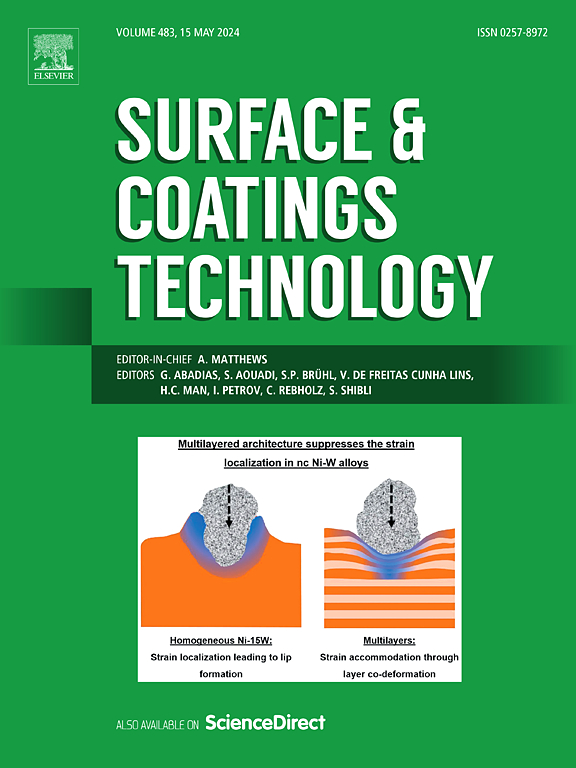Cold-sprayed Cu-WC/Cu/Cu-Ni@W multilayer deposits for high-quality repair of Cu alloy electromagnetic rails
IF 5.3
2区 材料科学
Q1 MATERIALS SCIENCE, COATINGS & FILMS
引用次数: 0
Abstract
In electromagnetic launch systems, the harsh service conditions coupling of electrical arc erosion, high temperature friction and high frequency of thermal shock make the surface of the high strength Cu alloy rail easily damaged. The conventional high-strength alloy repair layer faces challenges in balancing electrical conductivity with wear and arc erosion resistance. Addressing this challenge, in the present work, a novel multilayered repairing strategy is introduced by cold spraying pure Cu and Cu-based composite deposits for synergistically improving/balancing the adhesion, electrical conductivity and surface protection performance. The effects of the multilayered deposit structure design, strengthening particle surface modification, and heat treatment on adhesion, electrical conductivity, wear and arc erosion resistance of the deposits are investigated. An optimized multilayered structure composed of a Cu-WC bond coat, a pure Cu middle layer and a composite top layer deposited with Cu-Ni-clad W (Ni@W) powder is achieved. As compared with spraying pure Cu, an increase in adhesion from 14 MPa to 66 MPa is achieved via introducing Cu-WC composite bond coat on the CuCrZr substrate. For the top composite layer, as the Ni@W particles are used to strengthen pure Cu, the friction coefficient and wear rate decreases from 0.37 and 3.2 × 10−5 mm3·(N·m)−1 to 0.14 and 2.3 × 10−5 mm3·(N·m)−1, respectively, and the arc erosion depth and area decreased by 31.1 % and 81.0 % with the breakdown intensity improved by 50.6 % relative to the CuCrZr substrate. Meanwhile, a high electrical conductivity of 77.7 %IACS through the thickness direction is detected for the optimized multilayered deposit. Finally, a practical repair demonstration done on V-grooved CuCrZr substrates confirms the structural integrity and machinability of the cold sprayed multilayer composite deposit. The present work is attempted to offer a viable solution for improve the service performance and extending the service life of the metallic structures used in coupled harsh conditions.

冷喷涂Cu- wc /Cu/Cu-Ni@W多层镀层用于Cu合金电磁导轨的高质量修复
在电磁发射系统中,电弧侵蚀、高温摩擦和高频热冲击等恶劣的使用条件使得高强度铜合金导轨表面容易损坏。传统的高强度合金修复层在平衡导电性、耐磨损性和抗电弧侵蚀性方面面临挑战。为了应对这一挑战,本研究提出了一种新的多层修复策略,即冷喷涂纯Cu和Cu基复合镀层,以协同改善/平衡附着力、导电性和表面保护性能。研究了多层镀层结构设计、强化颗粒表面改性和热处理对镀层附着力、导电性、耐磨性和抗电弧侵蚀性能的影响。获得了由Cu- wc结合层、纯Cu中间层和Cu- ni包覆W (Ni@W)粉末沉积的复合顶层组成的优化多层结构。与喷涂纯Cu相比,在CuCrZr基体上引入Cu- wc复合粘结层,使涂层的附着力从14 MPa提高到66 MPa。与CuCrZr基体相比,Ni@W颗粒强化纯Cu后,复合层的摩擦系数和磨损率分别从0.37和3.2 × 10−5 mm3·(N·m)−1降低到0.14和2.3 × 10−5 mm3·(N·m)−1,电弧侵蚀深度和面积分别减少了31.1%和81.0%,击穿强度提高了50.6%。同时,优化后的多层镀层在厚度方向上的电导率高达77.7% IACS。最后,对v型槽CuCrZr基板进行了实际修复演示,验证了冷喷涂多层复合镀层的结构完整性和可加工性。本文的工作旨在为提高金属结构在耦合恶劣条件下的使用性能和延长使用寿命提供可行的解决方案。
本文章由计算机程序翻译,如有差异,请以英文原文为准。
求助全文
约1分钟内获得全文
求助全文
来源期刊

Surface & Coatings Technology
工程技术-材料科学:膜
CiteScore
10.00
自引率
11.10%
发文量
921
审稿时长
19 days
期刊介绍:
Surface and Coatings Technology is an international archival journal publishing scientific papers on significant developments in surface and interface engineering to modify and improve the surface properties of materials for protection in demanding contact conditions or aggressive environments, or for enhanced functional performance. Contributions range from original scientific articles concerned with fundamental and applied aspects of research or direct applications of metallic, inorganic, organic and composite coatings, to invited reviews of current technology in specific areas. Papers submitted to this journal are expected to be in line with the following aspects in processes, and properties/performance:
A. Processes: Physical and chemical vapour deposition techniques, thermal and plasma spraying, surface modification by directed energy techniques such as ion, electron and laser beams, thermo-chemical treatment, wet chemical and electrochemical processes such as plating, sol-gel coating, anodization, plasma electrolytic oxidation, etc., but excluding painting.
B. Properties/performance: friction performance, wear resistance (e.g., abrasion, erosion, fretting, etc), corrosion and oxidation resistance, thermal protection, diffusion resistance, hydrophilicity/hydrophobicity, and properties relevant to smart materials behaviour and enhanced multifunctional performance for environmental, energy and medical applications, but excluding device aspects.
 求助内容:
求助内容: 应助结果提醒方式:
应助结果提醒方式:


